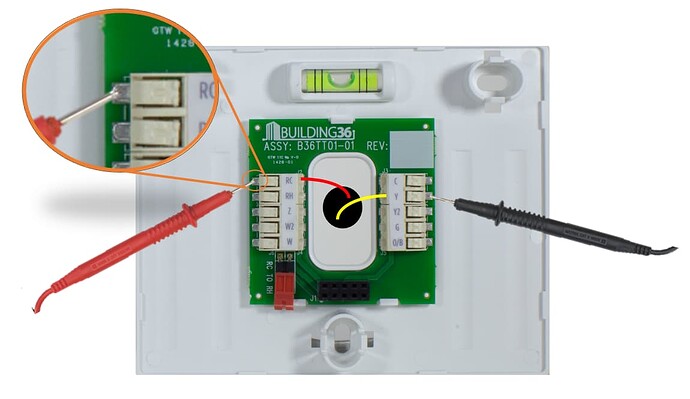Wiring troubleshooting
Basic wire checking
- Verify the wires are stripped to the correct length and are inserted correctly, making good contact with the terminal. If a multimeter is available, skip to Verify wiring with a multimeter below.
- Tug on the affected wire to see if it is loose in its terminal.
- Try removing the wire, check if it is stripped correctly and straight, then re-insert.
- Sometimes is easier to depress the terminal release button lightly as you insert the wire.
- If the issue is not resolved check out, continue to the section below on checking wires with a multimeter.
Verify wiring with a multimeter on an ADC-T2000
When checking the C, Y, Y2, G, and O/B wires:
- Using the red probe, touch the metal pad behind RC (or RH if that’s the connected terminal).
- Using the black probe, touch the metal pad behind the corresponding terminal you are testing (see Y in the diagram above).
- Verify that you are getting between 18-30 VAC on the multimeter.
- If you are getting 0 V, the RC wire is likely not connected, or the thermostat wires are not active.
- If you are getting something slightly greater than 0 V, the terminal you are testing is not connected properly.
- Remove the problem wire, re-strip, re-insert, and test again.
When checking the Z, W2, and W wires:
- Using the red probe, touch the metal pad behind RH.
- Using the black probe, touch the metal pad behind the corresponding terminal you are testing (see Y in the diagram above).
- Verify that you are getting between 18-30 VAC on the multimeter.
- If you are getting 0 V, the RH wire is likely not connected, or the thermostat wires are not active.
- If you are getting something slightly greater than 0 V, the terminal you are testing is not connected properly.
- Remove the problem wire, re-strip, re-insert, and test again.
Fan troubleshooting
Basic troubleshooting
- Verify the setpoint and ambient temp at the thermostat (remembering the swing setting).
- Verify that this is not a Heat Only system and that it does have a fan.
- Check thermostat configuration, especially for heat mode.
- Check the jumper. For more information, see Jumper.
- Check G-wire connection.
- Verify you are not in a Compressor Delay timeout or downtime Fan Duty Cycle.
- Listen for clicks. For more information, see Listening for clicks.
The fan is turning on too early
This is likely due to an improper thermostat configuration. Some heating systems will turn on the fan without the help of the thermostat, and build in a delay to allow the furnace to heat up.
Fan turns on when the heat turns on but is not supposed to do so
This is also due to improper configuration. Switch the heat type configuration from fossil to electric.
The fan is not turning on with my heat when expected
- Verify that the system is forced air and not radiator heating (even though the A/C is forced air) to see if the fan should even be running during heat. Determine if the site has radiators or baseboard heating.
- Please verify that the G wire is connected properly.
- Check the jumper. For more information, see Jumper.
- Verify the setting Heat Type is set to Electric and verify the setting is synced correctly with an updated timestamp.
